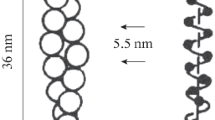Abstract
A synergetic law, being of common physicochemical and biological sense, is formulated: any evolving system that possesses an excess of free energy and elements with chiral asymmetry, while being within one hierarchical level, is able to change the type of symmetry in the process of self-organization increasing its complexity but preserving the sign of prevailing chirality (left — L or right — D twist). The same system tends to form spontaneously a sequence of hierarchical levels with alternating chirality signs of de novo formed structures and with an increase of the structures’ relative scales. In living systems, the hierarchy of conjugated levels of macromolecular structures that begins from the “lowest” asymmetric carbon serves as an anti-entropic factor as well as the structural basis of “selected mechanical degrees of freedom” in molecular machines. During transition of DNA to a higher level of structural and functional organization, regular alterations of the chirality sign D-L-D-L and L-D-L-D for DNA and protein structures, respectively, are observed. Sign-alternating chiral hierarchies of DNA and protein structure, in turn, form a complementary conjugated chiral pair that represents an achiral invariant that “consummates” the molecular-biological block of living systems. The ability of a carbon atom to form chiral compounds is an important factor that determined the carbon basis of living systems on the Earth as well as their development though a series of chiral bifurcations. The hierarchy of macromolecular structures demarcated by the chirality sign predetermined the possibility of the “block” character of biological evolution.
Similar content being viewed by others
References
V. A. Tverdislov, arXiv:1211.4272 (2012).
V. A. Tverdislov, A. E. Sidorova, and L. V. Yakovenko, Biophysics 57, 120 (2012).
V. I. Goldansky and V. V. Kuzmin, Uspekhi Fiz. Nauk 157, 3 (1989).
L. D. Barron, in Chirality at the Nanoscale: Nanoparticles, Surfaces, Materials and More, Ed. by D. B. Amabilino (WILEY-VCH Verlag GmbH & Co. KGaA, Weinheim, 2009), pp. 1–27.
R. Plasson, D. K. Kondepudi, H. Bersini, et al., Chirality 19, 589 (2007).
E. L. Eliel and S. H. Wilen, Stereochemistry of Organic Compounds (John Wiley & Sons, New York, 1994).
T. Way, Physical Bases of Molecular Biology (Izd. Dom “Intellekt”, Dolgoprudnyi, 2010) [in Russian].
A. Liljas, et al., Textbook of Structural Biology (World Scientific Publishing Co. Pte. Ltd New Jersey, London, Singapore, 2009).
Ph. C. Nelson, Science 337, 1045 (2012).
G. R. Ivanitsky, A. A. Deev, and E. P. Khizhnyak, Uspekhi Fiz. Nauk 175, 1207 (2005).
N. Nandi and D. Vollhardt, Chem. Rev. 103, 4033 (2003).
S. V. Stovbun and A. A. Skoblin, Vestn. MGU Ser. 3, Fiz. Astron., No. 3, 35 (2012).
C. Branden and J. Tooze, Introduction to Protein Structure, 2nd ed. (Garland Publishing, Inc., NY, 1999).
H. Schultz and R. Schirmer, Principles of Protein Structural Organization (Mir, Moscow, 1982) [in Russian].
A. V. Finkelstein and O. B. Ptitsyn, Protein Physics (KD Universitet, Moscow, 2012) [in Russian].
L. A. Blumenfeld and A. N. Tikhonov, Biophysical Thermodynamics of Intracellular Processes. Molecular Machines of the Living Cell (Springer-Verlag, New-York, 1994).
L. V. Yakovenko and V. A. Tverdislov, Biophysics 48, 1053 (2003).
V. A. Tverdislov and L. V. Yakovenko, Vestn. MGU Ser. 3, Fiz. Astron., No. 3, 3 (2008).
V. A. Tverdislov, L. V. Yakovenko, A. A. Ivlieva, and I. L. Tverdislova, Vestn. MGU Ser. 3, Fiz. Astron., No. 2, 3 (2011).
V. A. Tverdislov, A. E. Sidorova, and L. V. Yakovenko, Biophysical Ecology (URSS, KRASAND, Moscow, 2012) [in Russian].
Author information
Authors and Affiliations
Corresponding author
Additional information
Original Russian Text © V.A. Tverdislov, 2013, published in Biofizika, 2013, Vol. 58, No. 1, pp. 159–164.
Rights and permissions
About this article
Cite this article
Tverdislov, V.A. Chirality as a primary switch of hierarchical levels in molecular biological systems. BIOPHYSICS 58, 128–132 (2013). https://doi.org/10.1134/S0006350913010156
Received:
Published:
Issue Date:
DOI: https://doi.org/10.1134/S0006350913010156




